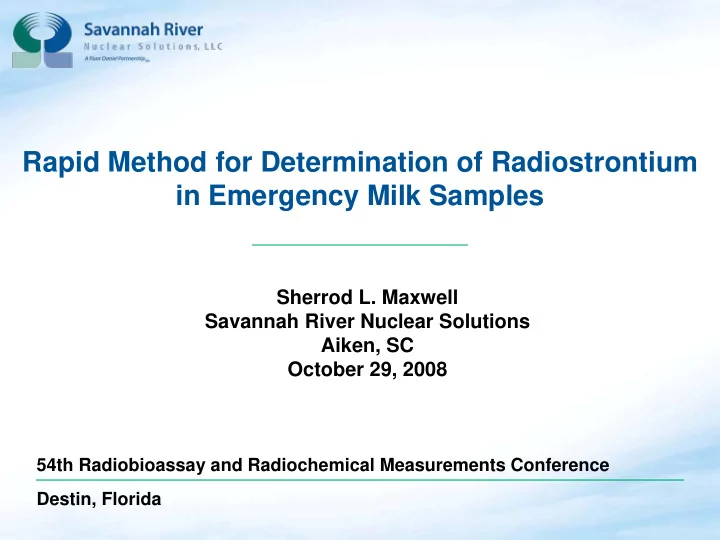

Rapid Method for Determination of Radiostrontium in Emergency Milk Samples Sherrod L. Maxwell Savannah River Nuclear Solutions Aiken, SC October 29, 2008 54th Radiobioassay and Radiochemical Measurements Conference Destin, Florida D O C U M E N T A T I O N & I N F O R M A T I O N S E R V I C E S 1 1
Background • Increasing need to develop faster analytical methods for emergency response - including rapid determination of radiostrontium in milk • Milk ingestion - Important pathway for radiostrontium intake into the human body - Accumulates in bone - 100 Bq /L Sr-90 generic emergency action level (IAEA) • Need for rapid method - Notification of dairy farms - Limits radiostrontium consumption 2
Need for faster methods • Classical method (Harley) of drying, furnacing, separations tedious and time-consuming • Cation exchange + extraction chromatography (Tait 1997) - bicyclic polyether cryptand such as cryptand 222 - long contact times / 24 hour method • Microwave small volume + Sr Resin (Tovedal 2008) - Measure Y-90 - 24 hours - LLD 50 Bq/L • Can we analyze in less than 24 hours? 3
New Method • New rapid separation method for radiostrontium in emergency milk samples - SRS Environmental lab • Flexible with sample aliquot - 100 ml aliquot yields 0.5 Bq/L LLD - 12 samples in 8 hours - Much less than 100 Bq/L Sr-90 emergency action level Maxwell III, SL and Culligan, B.K., “Rapid Method for Determination of Radiostrontium in Emergency Milk Samples”, Journal of Radioanalytical and Nuclear Chemistry, in press 4
Method Details • Calcium phosphate precipitation • Nitric acid dissolution of the precipitate - coagulates residual fat/proteins • Strontium separation - Sr Resin with vacuum-assisted flow rates • Gas proportional counting - Could apply Cerenkov option for Sr-89/ Sr-90 5
FlowChart of New Radiostrontium Emergency Method 12 Samples of Milk, 100 mL Aliquots Calcium 3 Hours Phosphate Precipitation + Acidification and Wet Ash 30 – 60 Minutes Furnace @ 550C Separation using 2.5 Hours Sr-Resin and Mounting Gas-Flow 20 – 60 Proportional Minutes Counting 6
Sample Preparation • 100 ml milk aliquot • Add 50 ml water to facilitate separation • Add 2 mL 1.25M Ca (NO 3 ) 2 and 5 mL (NH 4 ) 2 HPO 4 • Add phenolphthalein indicator • Add NH 4 OH to dark pink • Centrifuge 10 minutes 7
Sample Preparation • Add 20 mL of 3M HNO 3 into each tube • Ca 3 (PO 4 ) 2 dissolves • Fat/protein coagulate • Centrifuge • Transfer supernatant to beaker • Rinse solids with 10-15 ml 3M HNO 3 • Transfer supernatant to beaker • Evaporate beaker to dryness 8
Sample Preparation • Wet ash - 15 ml concentrated HNO 3 and 5 ml 30 wt% H 2 O 2 • Heat beakers in a furnace - at 550C for 30-60 minutes to turn the solids white • Wet ash - 10-15 ml concentrated HNO 3 and 5 ml 30 wt% H 2 O 2 • Redissolve in 10 ml 8 M HNO3 -1M Al(NO 3 ) 3 9
Sample Preparation 500 ml sample ppt. shown Ca 3 (PO 4 ) 2 and fat/protein Add 3M HNO3 10
11 Centrifuge Most fat/protein is removed Sample Preparation
12 Sample Preparation Heat on hot plate
13 Sample Preparation Heat to dryness
14 Heated at 550C 30 min. Sample Preparation
15 Column Load Solution
16 Gravity Vs Vacuum Flow Rates
Sr-89/90 in Milk Column Extraction • Redissolve in 10 ml 8M HNO 3 -1M Al(NO 3 ) 3 • Perform typical Sr Resin Separation using 3 ml Sr resin - (2 ml +1 ml cartridges) • Rinses: - 15 mL of 8M HNO3 - 5 ml 3M HNO3-0.05M oxalic acid - 7 ml 8M HNO3 • Sr Elution: 13 ml 0.05M HNO3 17
Performance of New Radiostrontium Method - 20 minute Count 90 Sr Added 90 Sr Measured Uncertainty Difference (Bq/L) (Bq/L) (%, K=2) (%) 0 0.26 8.9 N/A 0 0.34 81.9 N/A 2.86* 2.66 24.1 -7.0 2.86* 3.96 24.7 +38 2.86* 3.31 20.2 +15.7 2.86* 2.67 18.7 -6.6 5.70 6.11 16.7 +7.2 5.70 5.71 13.1 +0.2 5.70 5.16 13.9 -9.5 14.3 12.8 9.1 -11 14.3 15.2 8.5 +6.3 14.3 14.1 8.6 -1.4 Average +3.19 * Added using NRIP water standard 18
Performance of New Radiostrontium Method - 60 minute Count 90 Sr Added 90 Sr Measured Uncertainty Difference (Bq/L) (Bq/L) (%, K=2) (%) 0 0.11 130 N/A 0 0.27 59 N/A 2.86* 3.09 13.2 + 8.0 2.86* 3.11 16.7 +8.7 2.86* 2.67 13.6 -6.6 2.86* 2.67 11.3 -6.6 5.70 5.85 10.4 +2.6 5.70 5.75 8.3 +0.9 5.70 6.04 8.2 +5.9 14.3 13.6 6.1 -4.9 14.3 14.0 6.1 -2.1 14.3 14.2 6.1 -0.7 Average +0.52 * Added using NRIP water standard 19
Summary • New rapid emergency method for Sr in milk developed at SRS • Faster than cation exchange collection - 12 samples in 8 hours • Calcium phosphate precipitation and nitric acid dissolution to coagulate proteins/fats • LLD 0.5 Bq/L for 100 ml aliquot counted 20 minutes • Can also be used for larger aliquot routine environmental monitoring 20
Recommend
More recommend